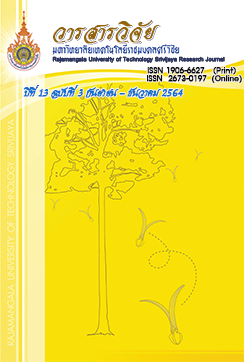การศึกษาปริมาณไมโครแว็กซ์ที่เหมาะสมในการเคลือบเชือกกล้วย สำหรับผลิตภัณฑ์งานประดิษฐ์
คำสำคัญ:
เชือกกล้วย, ไมโครแว็กซ์, งานประดิษฐ์บทคัดย่อ
การวิจัยครั้งนี้มีวัตถุประสงค์เพื่อศึกษาปริมาณไมโครแว็กซ์ที่เหมาะสมในการเคลือบเชือกกล้วยศึกษาคุณภาพของผลิตภัณฑ์เชือกกล้วยเคลือบไมโครแว็กซ์ และสำรวจการยอมรับของผู้บริโภคที่มีต่อผลิตภัณฑ์เชือกกล้วยเคลือบไมโครแว็กซ์ โดยทำการผลิตเชือกกล้วยจากกาบกล้วยสด วิเคราะห์ร้อยละของผลผลิตที่ได้ของเชือกกล้วยและค่าสี หลังจากนั้นทำการศึกษาปริมาณไมโครแว็กซ์ที่เหมาะสม โดยแปรเป็น 5 ระดับ คือ ร้อยละ 0, 25, 50, 75 และ 100 ในสารละลายพาราฟินความเข้มข้นร้อยละ 1 w/v ทำการเคลือบตามอัตราส่วนที่กำหนด เพื่อนำเชือกที่ได้มาวิเคราะห์คุณภาพ ได้แก่ การศึกษาลักษณะพื้นผิวด้วยกล้องจุลทรรศอิเล็กตรอนแบบส่องกราด ค่าสี ค่าความชื้น ค่าแรงดึงสูงสุด และสำรวจการยอมรับของผู้บริโภค ผลการวิจัย พบว่า เชือกกล้วยที่ได้มีผลผลิตร้อยละ 10 มีค่าความสว่าง (L*) เท่ากับ 63.41 ค่า (a*) เท่ากับ -0.18 และค่า (b*) เท่ากับ -3.76 ปริมาณไมโครแว็กซ์ที่เหมาะสมในการเคลือบเชือกกล้วยคือ ร้อยละ 25 โดยมีลักษณะพื้นผิวที่เรียบและสม่ำเสมอ มีค่าความสว่าง (L*) เท่ากับ 63.69 (a*) เท่ากับ 0.13 และ (b*) เท่ากับ -3.55 มีค่าร้อยละความชื้นเท่ากับ 5.35 และมีค่าแรงดึงสูงสุดเท่ากับ 117.79 นิวตัน ผลสำรวจการยอมรับของผู้บริโภค พบว่า ผู้บริโภคให้การยอมรับด้านรูปแบบ ด้านการนำไปใช้ประโยชน์และด้านความพึงพอใจโดยรวม คะแนนเฉลี่ย 4.24, 4.46 และ 4.32 ตามลำดับ
เอกสารอ้างอิง
Areechongcharoen, S., Phaisarntantiwong, N., Mongkholrattanasit, R. and Chonsakorn, S. 2013. Research Report no Development of textile Products from Lemongrass Fiber. Rajamangala University of Technology Phra Nakhon. (in Thai)
ASTM. 1999. ASTM D629-99. Standard Test Methods for Quantitative Analysis of Textiles. Annual Book of ASTM Standard. American Society for Testing and Materials, West Conshohocken, PA.
Bureau of Animal Nutrition Development. n.d. Using the produce from banana trees to raise animals. Available Source: http://nutrition.dld.go.th/Nutrition_Knowlage/ARTICLE/ArtileF.htm, September 1, 2019.
ISO. 1993. ISO 2062:1993(E). Textiles - Yarns from packages - Determination of single-end breaking force and elongation at break. International Standard. International Organization for Standardization. Vernier, Geneva.
Kalsirisilp, W. 2013. Development of Bag Product from Tied Dyeing of Banana Bark String. Master’s Thesis of Home Economics Technology, Rajamangala University of Technology Thanyaburi. (in Thai)
Kumpoun, W. n.d. Coating for fresh fruit. Available Source: https://stri.cmu.ac.th/article_detail.php?id=38,September 1, 2019.
Lotanaruk, S. 2015. Study on property of lumbering from banana fiber trees as guidelines for product design. Master’s Thesis of Product Design, Silpakorn University. (in Thai)
Na Ayudhya, I. 2010. ‘Value Innovation’ Strategic Product Planning. Academic Journal of Architecture, Chulalongkorn University (59): 161-174. (in Thai)
Rattanachaisit, P., Panpae, K. and Srikhirin, T. 1994. Separation of Emusa Fibers for Textile Production, pp. 238-248. In The 32nd Kasetsart University Annual Conference. Kasetsart University, Bangkok. (in Thai)
Sirikarn. 2011. Micro wax. Available Source: http://howtomakeflowercandle.blogspot.com/2011/09/blog-post_26.html, September 1, 2019.
Suthanukool, P. 2015. Research Report no Research and development of banana production for improvement of quality production and high value-added products. Department of Agriculture (Thai DOA). (in Thai)
Thai Industrial Standards Institute (TISI). 2017. Banana rope products. CPS.56/2017. Available Source: http://tcps.tisi.go.th/pub/tcps0056_60(ผลิตภัณฑ์จากเชือกกล้วย).pdf, July 25, 2019.
ดาวน์โหลด
เผยแพร่แล้ว
รูปแบบการอ้างอิง
ฉบับ
ประเภทบทความ
สัญญาอนุญาต
เนื้อหาและข้อมูลในบทความที่ลงตีพิมพ์ในวารสารวิจัยมหาวิทยาลัยเทคโนโลยีราชมงคลศรีวิชัย ถือเป็นข้อคิดเห็นและความรับผิดชอบของผู้เขียนบทความโดยตรง ซึ่งกองบรรณาธิการวารสารไม่จำเป็น ต้องเห็นด้วย หรือร่วมรับผิดชอบใดๆ
บทความ ข้อมูล เนื้อหา รูปภาพฯลฯ ที่ได้รับการตีพิมพ์ในวารสารวิจัย มหาวิทยาลัยเทคโนโลยีราชมงคลศรีวิชัย ถือเป็นลิขสิทธ์ของวารสารวิจัย มหาวิทยาลัยเทคโนโลยีราชมงคลศรีวิชัย หากบุคคลหรือหน่วยงานใดต้องการนำทั้งหมดหรือส่วนหนึ่งส่วนใดไปเผยแพร่ต่อหรือเพื่อการกระทำการใดๆจะต้องได้รับอนุญาตเป็นลายลักษ์อักษรจากวารสาร มหาวิทยาลัยเทคโนโลยีราชมงคลศรีวิชัยก่อนเท่านั้น







